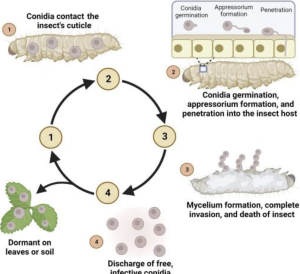Entomopathogenic fungi: Difference between revisions
Created page with "thumb|right|''Figure 1: The EMF Cycle.'' Entomopathogenic Fungi are parasitic microorganisms that infect insect hosts in many different ecosystems. They serve as a means to control insect populations and in doing so, prevents the overgrowth of insect organisms in soil environments and enhanced biodiversity. When infected, the insects eventually die off promoting the growth of soil microorganisms. They are then an energy source for microorganis..." |
No edit summary |
||
| Line 1: | Line 1: | ||
[[File:EMF_Life_Cycle.png|thumb|right|''Figure 1: The EMF Cycle.'']] | [[File:EMF_Life_Cycle.png|thumb|right|''Figure 1: The EMF Cycle.'']] | ||
Entomopathogenic Fungi are parasitic [[microorganisms]] that infect insect hosts in many different ecosystems. They serve as a means to control insect populations and in doing so, prevents the overgrowth of insect [[organisms]] in [[soil]] environments and enhanced biodiversity. When infected, the [[insects]] eventually die off promoting the growth of soil microorganisms. They are then an energy source for microorganisms and contribute to nutrient cycling and promote plant growth. Entomopathogenic Fungi can be referred to as "EPF" and are responsible for over 60% of insect deaths in nature. | Entomopathogenic Fungi are parasitic [[microorganisms]] that infect insect hosts in many different ecosystems. They serve as a means to control insect populations and in doing so, prevents the overgrowth of insect [[organisms]] in [[soil]] environments and enhanced biodiversity. When infected, the [[insects]] eventually die off promoting the growth of soil microorganisms. They are then an energy source for microorganisms and contribute to [[Nutrient Cycling|nutrient cycling]] and promote plant growth. Entomopathogenic Fungi can be referred to as "EPF" and are responsible for over 60% of insect deaths in nature. | ||
=Life Cycle= | |||
The fungi cycle begins with dormant fungi present on leaf, leaf litter, or soil ground. When an insect makes contact with this fungus, it attaches to the host organism's cuticle, or outside layer, preparing itself for penetration of the host. The next step involves germination of the conidia (asexual, non-motile spores) and the formation of the appressorium, which is almost like a peg produced by the conidia that can pierce the outer layer of the host organism. Once inside, step 3 begins and the hyphae begin to develop inside the host. Cell numbers rapidly multiply within the hemocoel (internal 'blood' and organs of the insect) until the hyphae grow enough to kill the organism. The final stage is fungal sporulation. Once the spores are developed, they get dispersed from the host organism. Some say this process could be more specific and split 4 steps into 6 steps, but the process remains the same. | |||
Revision as of 07:46, 1 April 2025

Entomopathogenic Fungi are parasitic microorganisms that infect insect hosts in many different ecosystems. They serve as a means to control insect populations and in doing so, prevents the overgrowth of insect organisms in soil environments and enhanced biodiversity. When infected, the insects eventually die off promoting the growth of soil microorganisms. They are then an energy source for microorganisms and contribute to nutrient cycling and promote plant growth. Entomopathogenic Fungi can be referred to as "EPF" and are responsible for over 60% of insect deaths in nature.
Life Cycle
The fungi cycle begins with dormant fungi present on leaf, leaf litter, or soil ground. When an insect makes contact with this fungus, it attaches to the host organism's cuticle, or outside layer, preparing itself for penetration of the host. The next step involves germination of the conidia (asexual, non-motile spores) and the formation of the appressorium, which is almost like a peg produced by the conidia that can pierce the outer layer of the host organism. Once inside, step 3 begins and the hyphae begin to develop inside the host. Cell numbers rapidly multiply within the hemocoel (internal 'blood' and organs of the insect) until the hyphae grow enough to kill the organism. The final stage is fungal sporulation. Once the spores are developed, they get dispersed from the host organism. Some say this process could be more specific and split 4 steps into 6 steps, but the process remains the same.